

Lambertsen Amphibious Respiratory Unit. The Lambertsen Amphibious Respiratory Unit (LARU, for short) is an early model of closed circuit oxygen rebreather, used by military frogmen.
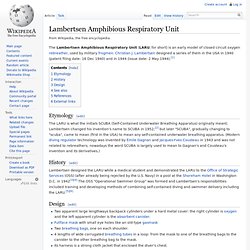
Christian J. Lambertsen designed a series of them in the USA in 1940 (patent filing date: 16 Dec 1940) and in 1944 (issue date: 2 May 1944).[1] Etymology[edit] Aqua Lung/La Spirotechnique. Newtsuit. The Newtsuit has fully articulated, rotary joints in the arms and legs.
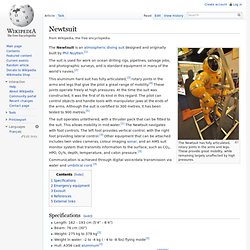
These provide great mobility, while remaining largely unaffected by high pressures. The Newtsuit is an atmospheric diving suit designed and originally built by Phil Nuytten.[1] The suit is used for work on ocean drilling rigs, pipelines, salvage jobs, and photographic surveys, and is standard equipment in many of the world’s navies.[2] This aluminum hard suit has fully articulated,[3] rotary joints in the arms and legs that give the pilot a great range of mobility.[4] These joints operate freely at high pressures.
At the time the suit was constructed, it was the first of its kind in this regard. The suit operates untethered, with a thruster pack that can be fitted to the suit. Communication is achieved through digital voice/data transmission via water and umbilical cord.[3] Specifications[edit] Siebe Gorman. Breathing tube (breathing apparatus) A 'breathing tube' is a flexible tube for breathing through, as part of a scuba set or other breathing apparatus or a medical oxygen apparatus or anaesthetic apparatus (Here they are distinguished from the medium-pressure hoses which are often found as parts of modern breathing apparatus.)

They are wide, and usually corrugated to let the user's head move about without the tube pinching at kinks. Each end usually has a screw connection. They may contain a one-way valve to keep the air or gas flowing the right way. According to the expected usage, they may be pure rubber, or rubber reinforced with canvas (outside or embedded) or similar. If the canvas layer is outside (as in the Siebe Gorman Salvus and the IDA71 and some old gasmasks, it protects the rubber from damage from scrapes but makes it harder to wash all the salt off after a saltwater dive.
Viper (rebreather) Siva (rebreather) Siva is a model series of frogman's rebreather made by Carleton Life Support originally made by Fullerton Sherwood Engineering Ltd.

They are: The Siva 55 is equipped with 2 200 bar (Inconel) spheres with a total volume of 5.6 litres. The Siva 55 (55 metres of depth) also known as (CCDA) Canadian Clearance Diving Apparatus works with any one of 3 Nitrox mixes (32.5, 40 and 60% Oxygen) or pure oxygen. The pure oxygen is used for closed circuit diving so the diver can work without bubbles. The other Nato standard B,C and D mix are standard nitrox mixes used in semiclosed-circuit mode. Mark IV Amphibian. Not to be confused with Lake C-IV Amphibian, which is a type of aircraft [1].
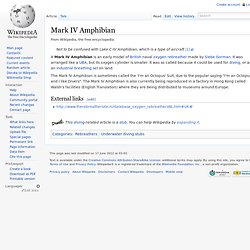
A Mark IV Amphibian is an early model of British naval oxygen rebreather made by Siebe Gorman. It was arranged like a UBA, but its oxygen cylinder is smaller. FROGS (rebreather) FROGS (Full Range Oxygen Gas System) is a make of rebreather for frogmen using oxygen, which has been used by the French Navy and the Commando Hubert since 15 October 2002.

It is made by the diving gear manufacturers Aqualung. Its working parts are in a dark-blue streamlined rounded shell. It can be worn on the front or on the back. It is rated as duration on a filling: oxygen 4 hours or more, soda-lime 7 hours at 21.1° C (70°F). It is 48 cm = 19.2 inches high, 30 cm = 12 inches wide, 19 cm = 7.6 inches thick. If the rebreathing loop fails, it can be switched into open-circuit mode bypassing the breathing bag, as bailout.
Halcyon RB80. The Halcyon RB80 is a non-depth-compensated passive addition semi-closed circuit rebreather of similar external dimenrions to a standard AL80 scuba cylinder (11 litre, 207 bar aluminium cylinder, 185mm diameter and about 660mm long).
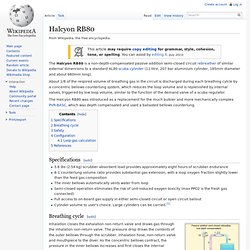
About 1/8 of the respired volume of breathing gas in the circuit is discharged during each breathing cylcle by a concentric bellows counterlung system, which reduces the loop volume and is replenished by internal valves, triggered by low loop volume, similar to the function of the demand valve of a scuba regulator. The Halcyon RB80 was introduced as a replacement for the much bulkier and more mechanically complex PVR-BASC, which was depth compensated and used a ballasted bellows counterlung. Three bolt equipment. Diving equipment. Diving equipment is equipment used by underwater divers to make diving activities possible, easier, safer and/or more comfortable.
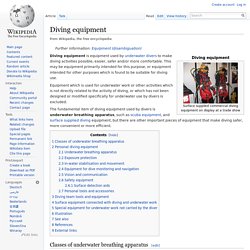
This may be equipment primarily intended for this purpose, or equipment intended for other purposes which is found to be suitable for diving use. Porpoise (scuba gear) An example of the world's first commercially available, single hose SCUBA unit designed and manufactured by Ted Eldred in 1952.

Porpoise is a tradename for scuba developed by Ted Eldred in Australia and made there from the late 1940s onwards. Atmospheric diving suit. An atmospheric diving suit or ADS is a small one-man articulated submersible of anthropomorphic form which resembles a suit of armour, with elaborate pressure joints to allow articulation while maintaining an internal pressure of one atmosphere.
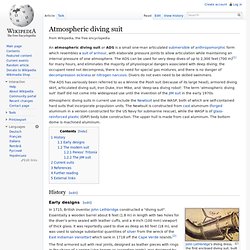
The ADS can be used for very deep dives of up to 2,300 feet (700 m)[1] for many hours, and eliminates the majority of physiological dangers associated with deep diving; the occupant need not decompress, there is no need for special gas mixtures, and there is no danger of decompression sickness or nitrogen narcosis. Divers do not even need to be skilled swimmers. The ADS has variously been referred to as a Winnie the Pooh suit (because of its large head), armored diving skirt, articulated diving suit, Iron Duke, Iron Mike, and 'deep-sea diving robot'. Aqua-lung. Aqua-Lung[1] was the original English name of the first open-circuit, self-contained underwater breathing apparatus (or "SCUBA") to reach worldwide popularity and commercial success.
This class of equipment is now commonly referred to as a diving regulator[2] or demand valve. The Aqua-Lung was invented in Paris during the winter of 1942–1943 by two Frenchmen; the engineer Émile Gagnan and Naval Lieutenant ("lieutenant de vaisseau") Jacques Cousteau. Invention and patent[edit] An earlier underwater breathing regulator, known as the régulateur, was invented in France in 1860 by Benoît Rouquayrol. He first conceived it as a device to help assist in escaping from flooded mines.
JIM suit. A JIM suit used by NOAA is recovered from the water The JIM suit is an atmospheric diving suit (ADS), which is designed to maintain an interior pressure of one atmosphere despite exterior pressures, eliminating the majority of physiological dangers associated with deep diving. Because there is no need for special gas mixtures, and there is no danger of nitrogen narcosis or decompression sickness (the 'bends'); the occupant does not need to decompress when returning to the surface. It was invented in 1969 by Mike Humphrey and Mike Borrow*, partners in the English firm Underwater Marine Equipment Ltd (UMEL), assisted by Joseph Salim Peress, whose Tritonia diving suit acted as their main inspiration.
The suit was named after Jim Jarrett, Peress' chief diver. History[edit] Its first commercial deployment was in 1974, when JIM suits were used in the recovery of lost oil tanker anchor chains in a Canary Islands harbor. Michael J. Specifications[edit] Siebe Gorman CDBA. The Siebe Gorman CDBA from three angles The Clearance Divers Breathing Apparatus (CDBA) is a type of rebreather made by Siebe Gorman in England. The British Royal Navy used it for many years.[1] It was for underwater work rather than for combat diving. The main oxygen cylinders are on the diver's back. The oxygen cylinders at the front of the diver are for bailout. In its basic mode it was an oxygen rebreather; but some of the cylinders could be replaced by diluent cylinders for nitrox mode (which the Navy called "mixture"), and then the set was sometimes called CDMBA.
Diving mask. Snorkeler wearing a soft silicone diving mask Construction[edit] Scuba diver with bifocal lenses in mask. IDA71. Diving suit. Standard diving dress. KISS (rebreather) Halcyon PVR-BASC. Schematic diagram of the breathing loop and gas supply pneumatics of the Halcyon PVR-BASC Rebreather. 1 DSV/BOV with non-return valves2 Exhalation hose3 Primary water trap4 Manual drain pump5 Overpressure relief valve6 Main bellows counterlung7 Discharge bellows counterlung (variable volume)8 Discharge valve9 Axial flow scrubber with secondary water trap10 Feed gas demand valves11 Inhalation hose12 Feed gas supply cylinder13 Cylinder valve14 High pressure regulator (1st stage)15 Submersible pressure gauge16 Intermediate pressure gas connectors17 Drain port for cleaning and drying counterlung.
Full face diving mask. Cis-Lunar. This article is about the manufacturing company. Viper (rebreather) Air hose. Air hoses are used in underwater diving, such as scuba diving, to carry air from the surface or from air tanks or diving pumps to the diver. Escape set. Pony bottle. A pony bottle is a small independently filled diving cylinder, often of only a few litres capacity, which forms an extended scuba set and which is fitted with its own independent regulator. In an emergency, such as depletion of the diver's main air supply, it can be used as an alternate air source or bailout bottle to allow a normal ascent in place of a controlled emergency swimming ascent. Breathing performance of regulators.
Sladen Suit. Snuba. Scuba set. Davis Submerged Escape Apparatus. Orinasal mask. Momsen lung. Ted Eldred. Diving regulator. CDBA. Siebe Gorman Salvus. Rebreather. Mouthpiece (scuba)